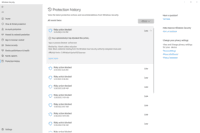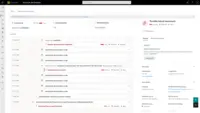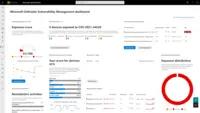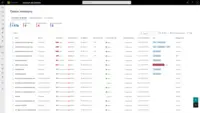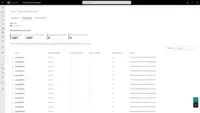Microsoft Defender for EndpointFormerly Microsoft Defender ATP
Overview
What is Microsoft Defender for Endpoint?
Microsoft Defender for Endpoint (formerly Microsoft Defender ATP) is a holistic, cloud delivered endpoint security solution that includes risk-based vulnerability management and assessment, attack surface reduction, behavioral based and cloud-powered next generation protection, endpoint detection and response (EDR), automatic investigation…
A reliable End to end security package.
Perfect Endpoint Security, Exposure Detection and Management Tool.
Microsoft Defender for Endpoint Review
Quick to rollout and get going, but takes some tweaking to optimize.
Microsoft Defender Review
The one stop security shop for the endpoints
Decent Protection for your endpoints
Microsoft Defender for Endpoint, a must for every Windows based IT setup
"Microsoft Defender for Endpoint One of the best tool to manage threat, Vulnerability and Compliance of the endpoints."
Secure workstations with MDE
Defender for Endpoint - First class EDR and more.
A Comprehensive Look at Microsoft Defender for Endpoint. Defending with Style
Defend, Detect, Excel with Microsoft Defender for Endpoint
Microsoft Defender for Endpoint
How Microsoft Defender for Endpoint Differs From Its Competitors
Components
Protection Scope
Components
- Vulnerability Management
- Baseline Assessments
- Device Discovery
- Endpoint Security Policies
- Automated Remediation
- Dynamic Device Tagging
- Endpoint DLP
- Web Content Filtering
- Live Response
- Unified integration with Defender for Cloud
- Always remediate PUA
- Device Deception (Preview)
- Download quarantined files
- Evaluatio…
Protection Scope
Components
Endpoint Detection and Response (EDR) : Organizations can investigate security incidents, collect pertinent data, and implement the necessary remediation activities to eliminate and contain threats by using …
Protection Scope
We are protecting over 30 Windows devices for our company, as well as more than 50 Windows and macOS devices for one of our customers. We also use Microsoft Intune to manage over …
Components
2. Advanced Threat Protection
3. Attack Surface Reduction
Protection Scope
Components
Protection Scope
Components
Protection Scope
Components
Protection Scope
Components
Protection Scope
Components
Protection Scope
Components
- Attack Surface Reduction (ASR).
- Next-generation Protection.
- Microsoft Secure Score for Devices.
- Automated Investigation and Remediation (AIR).
Protection Scope
Components
Components
Components
Protection Scope
Components
Protection Scope
Components
Awards
Products that are considered exceptional by their customers based on a variety of criteria win TrustRadius awards. Learn more about the types of TrustRadius awards to make the best purchase decision. More about TrustRadius Awards
Popular Features
- Malware Detection (53)8.585%
- Infection Remediation (52)8.282%
- Anti-Exploit Technology (51)8.080%
- Centralized Management (52)7.979%
Reviewer Pros & Cons
Pricing
Academic
$2.50
Standalone
$5.20
Entry-level set up fee?
- No setup fee
Offerings
- Free Trial
- Free/Freemium Version
- Premium Consulting/Integration Services
Product Demos
Microsoft Defender for Endpoint Overview
Features
Endpoint Security
Endpoint security software protects enterprise connected devices from malware and cyber attacks.
- 8Anti-Exploit Technology(51) Ratings
In-memory and application layer attack blocking (e.g. ransomeware)
- 8.5Endpoint Detection and Response (EDR)(51) Ratings
Continuous monitoring and response to advanced internet threats by endpoint agents.
- 7.9Centralized Management(52) Ratings
Centralized management supporting multi-factor authentication, customized views, and role-based access control.
- 7.8Hybrid Deployment Support(10) Ratings
Administrators should be able to choose endpoint security on-premise, cloud, or hybrid.
- 8.2Infection Remediation(52) Ratings
Capability to quarantine infected endpoint and terminate malicious processes.
- 8.3Vulnerability Management(50) Ratings
Vulnerability prioritization for fixes.
- 8.5Malware Detection(53) Ratings
Detection and blocking of zero-day file and fileless malware.
Product Details
- About
- Competitors
- Tech Details
- FAQs
What is Microsoft Defender for Endpoint?
Rapidly
stops threats: Protects against sophisticated threats such as
ransomware and nation-state attacks.
Scales security: Puts time back in the hands of defenders to prioritize risks and elevate the organization's security posture.
Evolves the organization's defenses: Goes beyond endpoint silos and mature the organization's security based on a foundation for extended detection and response (XDR) and Zero Trust.
Microsoft Defender for Endpoint Features
Endpoint Security Features
- Supported: Anti-Exploit Technology
- Supported: Endpoint Detection and Response (EDR)
- Supported: Centralized Management
- Supported: Infection Remediation
- Supported: Vulnerability Management
- Supported: Malware Detection
Microsoft Defender for Endpoint Screenshots
Microsoft Defender for Endpoint Video
Microsoft Defender for Endpoint Competitors
Microsoft Defender for Endpoint Technical Details
| Deployment Types | On-premise |
|---|---|
| Operating Systems | Windows |
| Mobile Application | No |
Frequently Asked Questions
Comparisons
Compare with
Reviews and Ratings
(174)Attribute Ratings
Reviews
(1-19 of 19)- It has a very intuitive and user-friendly UI that enables my team and I to navigate through it and respond to any threat efficiently.
- It's extensive dashboard gives a complete view of all our endpoint soo we can spot any potential threat and exposure across the networks.
- Robust detection and response capabilities that detect abnormal behavior, potential threats, and attacks as they happen and remediate and block any threat.
- Insights enable us to get to the root cause of incidents and alerts for deep investigation.
- It also provide a powerful 365 protection against any threat.
- It is pretty limited when it comes to devices that are not Microsoft-based. Adding a device is quite a task.
- False positives.
- Sophisticated automated investigation and response features.
- Exclusions during scanning are hard to spot.
- I always have to submit request for whitelisting apps.
Microsoft Defender Review
- Endpoint protection
- Basis level DLP
- Firewall security for endpoint.
- EDR - provides basic EDR capabilities
- Doesn't come as an individual product
- Threat Intelligence is not upto the market standards.
The one stop security shop for the endpoints
- Vulnerability Management is without a doubt one of the most efficient features of Microsoft Defender for Endpoint. It provides enough details about the vulnerability, its impact and the remediation as well.
- The latest addition of 'Endpoint Security Policies' has been a very well thought and insightful feature that relieves the security analysts from the hassle of switching to Intune just for reviewing the endpoint security policies.
- 'Automated Remediation' is a boon to many organizations across the industry that helps in responding to ongoing attacks at machine speed. Microsoft Defender for Endpoint does it quite well in terms of accuracy and quickness.
- Dynamic device tagging feature has been an underrated feature from Microsoft Defender for Endpoint. It is such a reliable and efficient feature that saves a lot of time whether you are dealing with vulnerabilities or incidents.
- While 'Vulnerability Management' is one of my favorite features, I do feel that it has been the same for quite some time and now it should have some integration capabilities to do actions like inform the affected users, or take small actions like updating the OS, sending prompts to devices etc.
- I think most people will agree with me when I say that 'Baseline Assessments' feature should now have more standards added to its inventory. CIS and STIG are the only ones available in this feature without any updates for a long time now.
- Device Discovery while a good feature is appearing to somewhat unstable in nature. It does not provide admins with enough details and any actions to take on the discovered devices.
Microsoft Defender for Endpoint will be a great choice when you are a big organization (more than 500 endpoints) and are dealing with customer data from a critical industry.
Although if you lie in the SMB segment, taking standalone Microsoft Defender for Endpoint plans will make you confused about which features to go for and which ones to let go off. Hence, explore other options here.
"Microsoft Defender for Endpoint One of the best tool to manage threat, Vulnerability and Compliance of the endpoints."
- It provides a unified security experience when combined with other Microsoft products such as Microsoft Defender for 365 and Azure Defender.
- It has an excellent dashboard and centralized view that make it easy to see and control everything from one location.
- It's an EDR tool designed to help you understand incidents and alerts better.
- Real-time detection of attacks and prompt endpoint device responses. It effortlessly interacts with additional Microsoft security products.
- I must admit that I haven't discovered anything major regarding this product.
- It has limited integration options with third party security products.
- Sometime Automated Response is slow.
Secure workstations with MDE
- It blocks the unsafe applications from accessing.
- It provides User-friendly interface for seamless endpoint security.
- It gets the updates new pattern updates automatically and stays upto date.
- It has limited integration options with third party products.
- Expand Baseline Assessment beyond STIG and CIS benchmarks for broader security coverage and compliance flexibility.
- Nothing else.
Defend, Detect, Excel with Microsoft Defender for Endpoint
- Automated incident response
- Scalability
- Rapid threat mitigation
- Threat analytics keeping us aware of our security posture.
- Transparency in alert logic and visibility
- Clarity in licensing. There are many options and pricing tiers that aren't very clear at the start of deployment.
- Limited baseline assessment
Microsoft defended for endpoint user experience review.
- The threat detection is very good in Defender, during log4j exploitation we got a great deal of support from the Defender, and proactive coverage was received.
- During a recent security incident in our organization, the defender support team was quick to hop in and release the emergency patches and malware signature updates via hotfix, which has helped us deal with the security incident proactively.
- The ease of deployment on the endpoint and scanning feature, which consume minimal resources, and the offline and online coverages of threats are great advantages of Defender.
- Sometimes interacting with the support becomes difficult and more technical side, people who can understand customer concerns better will be of great help.
- Offline coverage can be even better.
- So far, I have had the best experience with defenders, and there is not much to complain about defenders.
Microsoft Defender for Microsoft Endpoint.
- Threat Protection.
- Endpoint Detection and Response (EDR),
- Advanced Analytics.
- Linux VMs.
- MAC OS VMs.
- iOS Platform.
Microsoft Defender for Endpoint-Best EDR Solution
- Microsoft Defender for Endpoint helps customers to more tightly integrate into the OS
- ATP integrate with their cloud based sandbox for malware analysis
- Microsoft Defender for Endpoint Antivirus provide ML based scanning
- Mac & Linux EDR visibility is weak spot for Microsoft Defender for Endpoint
- ATP does not have malware search functionality
- ATP includes dashboards for specific threats but not actor attributions
Microsoft Defender for Endpoint gives visibility on enable devices on endpoints but lacks visibility of unmanaged devices in the network. Customers can configure device controls via Intune but it is limited to windows 10 only.
All-in-one subscription - good suites.
- Protect very well.
- Is lightweight.
- One subscription for all service.
- Integration with firewall.
- Logging, there are low log.
- Interface design could be better.
My experience using Microsoft Defender for Endpoint
- Notifications (alerts)
- Register and control of a big amount of devices
- Complete antimalware
- Problems to run integrations with other tools
- Security policies setup is hard
- Technical documentation
A no brainer for anyone using the Microsoft stack
- Front line next gen AV
- Integrated well into other MS security products
- It's simple to use and configure
- Better support for servers
Endpoint protection products that are easy to use and configure
- The ability to provide decision support (or content about alerts) is powerful and allows us to become experts in analytics rather than in a specific technology
- Microsoft Defender provides security for unmanaged devices on corporate networks
- Microsoft Defender for Endpoint is a service in the Microsoft Defender Security Center. By adding and deploying client provisioning profiles, configuration administrators can monitor deployment status and obtain endpoint agent health status using Microsoft Defender.
- Windows Defender isn't perfect. It may miss some threats, especially new and sophisticated threats. So it’s important to supplement it with other security measures.
- Even though Windows Defender does a good job, it can't protect you from everything. Therefore, it is important to be aware of the risks and take steps to protect your computer, such as using complex passwords and being careful about clicking on anything, especially email attachments and some tech support scam calls.
Microsoft Endpoint Defender - A powerful security system in place
- Incidence Response
- Threat Intelligence
- Real time monitoring
- Third party integration with Microsoft defender for endpoint is tough as its not compatible with many systems
- Custom rule creation and enhanced analytics features needs a lot of improvement
- It should be compatible with MacOS and Linux as well
- Easy deployment for windows devices
- It does a great job of updating the threat protection database to keep up with those zero-day vulnerabilities
- Works great with Windows OS system without causing resource conflicts or system performance degradation
- Hard to integrate with third party SIEM solution
- Not available for OS other than Windows
- It is a little hard to do threat analysis or investigation when you try to correlate the detection with other security control systems like firewalls, web proxies, etc.
Microsoft Defender for Endpoint for the MSP masses
- Protecting desktops
- Protecting laptops
- Managing our cyber security technology stack
- Tight integration with our RMM
Best protection from Microsoft.
- Offline protection.
- Actively scan files and process them in the background.
- Protection history.
- Scheduled scans.
- Performance optimizations.
- Incorporate behavior analysis.
- Improve user interface and usability.
Microsoft Defender for Endpoint Review
- Cloud Console
- Cloud based updates
- Live protection
- AV/Malware protection
- Vulnerability Management
- End Point Detection and Response (EDR)
- Onboarding devices
- Device configuration can be challenging
- In order to use this product to its full capabilities, Intune will be required
Vulnerability management is a nice feature. It allows for vulnerabilities to be factored in for an overall exposure score.
Secure Score .
We utilize EDR as well. It makes easier for our Incident Response team to built a timeline. We're using Defender more when it comes to IR.
Great AV solution that's low on system resources!
- It does not take up a lot of system resources, unlike other 3rd part AV providers.
- Integrated into the MS product line without having to touch it too much, unlike 3rd part AV providers.
- Easy to set-up and manage endpoints.
- It does not break Windows OS like 3rd party AV providers whenever a patch or roll updated is deployed.
- Detection rates are less than some of the competitors out there.
- Too many false positives with 3rd part applications.
- For smaller deployments can get expensive compared to competitors.


